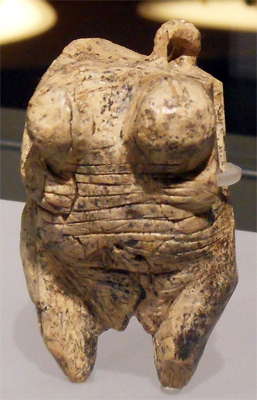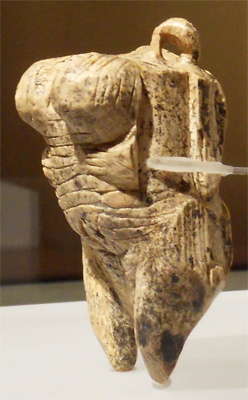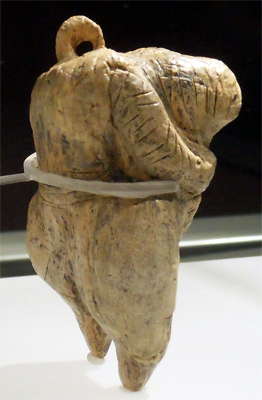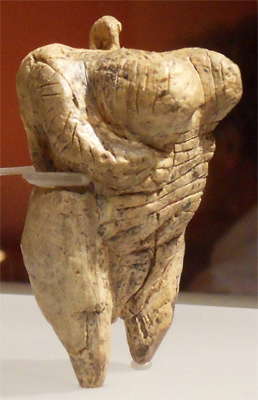The Venus of Hohle Fels
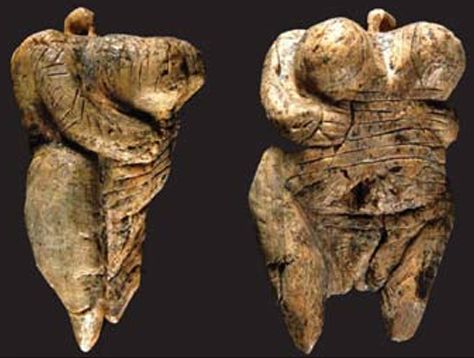
The Venus of Hohle Fels is an Upper Paleolithic Venus figurine dated to between 35 000 and 40 000 years ago, belonging to the early Aurignacian, and is the oldest undisputed example of Upper Paleolithic art and figurative prehistoric art in general
Photo: H. Jensen. © Universität Tübingen.
This is a most unusual venus. It carries the apparent wish not to show the face of the earth mother figure to its logical extreme, and the head and face have been replaced altogether with just a small loop of ivory for a cord.
In addition, in marked contrast to other venus figures, it has not been polished or at least smoothed. Instead it has deep markings on the breasts, arms and abdomen that look like cicatrices, cuts in the skin that have been immediately rubbed with ash to make them stand out from the rest of the body. These are similar markings to the animal figures from the nearby cave of Vogelherd.
The breasts of the figure have been greatly exaggerated, and jut out from the body in an unnatural manner. The shoulders are broad and strong. The abdomen is in keeping with the thick thighs, yet the buttocks are almost non-existent. There are no hands or feet shown.

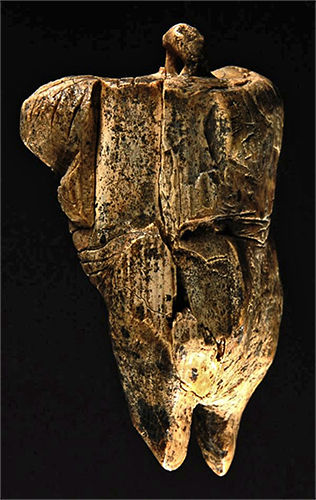
The Venus of Hohle Fels.
Photo: H. Jensen, © University of Tübingen
Proximate source: http://www.schule-bw.de/unterricht/faecher/geschichte/unterricht/unterrichtsekI/vorgeschantike/vorgesch/venus/bilder.html
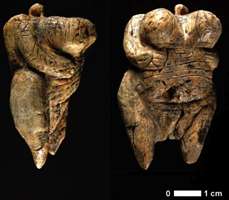
The Venus of Hohle Fels.
Photo: H. Jensen. © Universität Tübingen.
 Picture of the excavation. The red arrow shows where the Venus was found.
Picture of the excavation. The red arrow shows where the Venus was found.
Photo: M. Malina. © Universität Tübingen.
Photo: Silosarg
Source: Original, at Urgeschichtliches Museum, 89143 Blaubeuren, Germany
Date: 2010.07.18
Permission: licensed under the Creative Commons Attribution 3.0 Unported license.
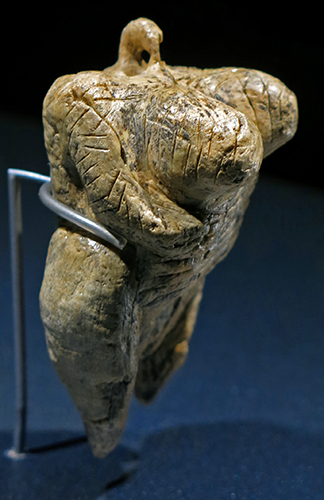
The Venus of Hohle Fels, height 59.7 mm.
Photo: Don Hitchcock 2015
Source: Urgeschichtliches Museum Blaubeuren
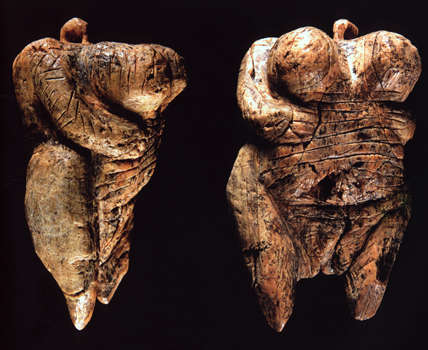
The Venus of Hohle Fels, height 59.7 mm.
Photo: Cook (2013)
Ivory Venus Figurine From The Swabian Jura Rewrites Prehistory
The 2008 excavations at Hohle Fels Cave in the Swabian Jura of southwestern Germany recovered a female figurine carved from mammoth ivory from the basal Aurignacian deposit. This figurine, which is the earliest depiction of a human, and one of the oldest known examples of figurative art worldwide, was made at least 35 000 years ago. This discovery radically changes our views of the context and meaning of the earliest Paleolithic art.
Between September 5 and 15, 2008 excavators at Hohle Fels near the town of Schelklingen recovered the six fragments of carved ivory that form the Venus. The importance of the discovery became apparent on September 9 when an excavator recovered the main piece of the sculpture that represents the majority of the torso. The figurine lay about 3 meters below the current surface of the cave in an area about 20 meters from the cave’s entrance. The finds come from a single quarter meter and were recovered from within 8 cm in the vertical dimension. The Venus from Hohle Fels is nearly complete with only the left arm and shoulder missing. The excellent preservation and the close stratigraphic association of the pieces of the figurine indicate that the Venus experienced little disturbance after deposition.
The figurine originates from a red-brown, clayey silt at the base of about one meter of Aurignacian deposits.The Venus lay in pieces next to a number of limestone blocks with dimension of several tens of centimetres. The find density in the area of the Venus is moderately high with much flint knapping debris, worked bone and ivory, bones of horse, reindeer, cave bear, mammoth, ibex, as well as burnt bone.
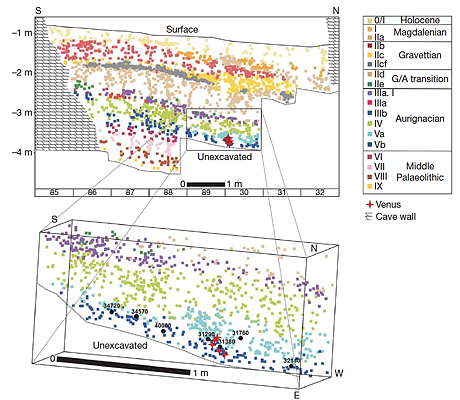
Stratigraphic position of the Venus of Hohle Fels and associated radiocarbon dates from archaeological horizon Va feature 10 and Vb. The lower
plot shows the radiocarbon dates (in years before present) of some of the samples found near the Venus . Figure by M. Malina.
Photo: Conard (2009)
Radiocarbon dates from this horizon span the entire range from 31 000 – 40 000 years ago. The fact that the venus is overlain by five Aurignacian horizons that contain a dozen stratigraphically intact anthropogenic features with a total thickness of 70 – 120 cm, suggests that figurine is indeed of an age corresponding to the start of the Aurignacian around 40 000 years ago.
Although much ivory working debris has been recovered from the basal Aurignacian deposits at Hohle Fels and the nearby site of Geißenklösterle, this sculpture is the first example of figurative art recovered from the basal Aurignacian in Swabia. The discovery of the Venus of Hohle Fels refutes claims that figurative representations and other symbolic artifacts first appear the later phases of the Swabian Aurignacian.
The Venus shows a range of entirely unique features as well as a number of characteristics present in later female figurines. The Venus of Hohle Fels lacks a head. Instead an off-centered, but carefully carved ring is located above the broad shoulders of the figurine. This ring, despite being weathered, preserves polish suggesting that the figurine was worn as a pendant. Beneath the shoulders, which are roughly as thick as they are wide, large breasts project forward. The figurine has two short arms with two carefully carved hands with visible fingers resting on the upper part of the stomach below the breasts.
The Venus has a short and squat form with a waist that is slightly narrower than the broad shoulders and wide hips. Multiple deeply incised horizontal lines cover the abdomen from the area below the breast to the pubic triangle. Several of these horizontal lines extend to the back of the figurine and are suggestive of clothing or a wrap of some sort. Microscopic images show that these incisions were created by repeatedly cutting along the same lines with sharp stone tools. The legs of the Venus are short and pointy. The buttocks and genitals are depicted in more details. The split between the two halves of the buttocks is deep and continues without interruption to the front of the figurine where the vulva is visible between the open legs. There can be no doubt that the depiction of oversized breast, exentuated buttocks and genitalia result from the deliberate exaggeration of the sexual features of the figurine. In addition to the many carefully depicted anatomical features, the surface of the Venus preserves numerous lines and deliberate markings.
Many of the features, including the emphasis on sexual attributes and lack of emphasis on the head, face and arms and legs, call to mind aspects of the numerous Venus figurines well known from the European Gravettien, which typically date between 22 000 and 27 000 BP. The careful depiction of the hands is reminiscent of those of Venuses including that of archetypal Venus of Willendorf, which was discovered 100 years earlier in summer of 1908. Despite the far greater age of the Venus of Hohle Fels, many of its attributes occur in various forms throughout the rich tradition of Paleolithic female representations.
The new figurine from Hohle Fels radically changes our view of origins of Paleolithic art. Prior to this discovery, animals and therianthropic imagery dominated the over two dozen figurines from the Swabian Aurignacian. Female imagery was entirely unknown. With this discovery, the notion that three dimensional female imagery developed in the Gravettian can be rejected. Also the interpretations suggesting that strong, aggressive animals or shamanic depictions dominate the Aurignacian art of Swabia, or even Europe as a whole, need to be reconsidered. Although there is a long history of debate over the meaning of Paleolithic Venuses, their clear sexual attributes suggest that they are a direct or indirect expression of fertility. The Venus of Hohle Fels provides an entirely new view of the art from the early Upper Paleolithic and reinforces the arguments that have been made for innovative cultural manifestations accompanying the rise of the Swabian Aurignacian.
While many researchers, including Nicholas Conard, assume that the Aurignacian artworks were made by early modern humans shortly after their migration into Europe, this assumption can neither be confirmed or refuted based on the available skeletal data from the Swabian caves. The Venus of Hohle Fels forms a center piece for a major exhibit in Stuttgart entitled Ice Age Art and Culture, which will run from September 18, 2009 – January 10, 2010.
Journal Reference: Conard (2009)
40 000-year-old carved figure of a voluptuous woman excavated in Germany
By Thomas H. Maugh IIMay 14, 2009

The figurine, found in 2008 in a cave in Schelklingen, southern Germany is thought to be the world's oldest reproduction of a human.
Photo: David Maurer Associated press
Source: http://www.latimes.com/news/nationworld/nation/la-sci-venus14-2009may14,0,181830.story
A 40 000-year-old figurine of a voluptuous woman carved from mammoth ivory and excavated from a cave in southwestern Germany is the oldest known example of three-dimensional or figurative representation of humans and sheds new light on the origins of art, researchers reported Wednesday.
The intricately carved headless figure is at least 5 000 years older than previous examples and dates from shortly after the arrival of modern humans in Europe. It exhibits many of the characteristics of fertility, or Venus, figurines carved millenniums later.
The figurine "radically changes our views of the context and meaning of the earliest Paleolithic art," its discoverer, archaeologist Nicholas J. Conard of the University of Tubingen in Germany, wrote in the journal Nature.
Experts are excited about the find because of what it tells us about early humans -- and about ourselves.
"The origin and evolution of figurative art, portable art, appear on most lists of what constitutes modern human behavior," said archaeologist Daniel Adler of the University of Connecticut, who was not involved in the research.
"Any time you can push the clock back on some of these behaviors, we get a better understanding of why these were important and were developed, where they were developed . . . and the roles they played in the social glue that holds groups together," he said.
"For European archaeologists, it marks the appearance of behaviors they find familiar, modern human behavior," said archaeologist John J. Shea of Stony Brook University in New York, who was also not involved. "It suggests the same values and ways of seeing the world existed among the earliest humans that migrated to Europe" as among humans today.
The figurine was excavated at Hohle Fels, a large cave in the Swabian Jura region about 14 miles southwest of the city of Ulm. The cave shows evidence of a long period of prehistoric occupation and is probably best known for three ivory carvings previously discovered by Conard: a horse's or bear's head; a water bird that may be in flight; and a half-human, half-lion figurine, all dating from about 30 000 to 31 000 years ago.
The new figurine was found in September in six pieces about 9 feet below the cave floor. Nearby were flint-knapping debris, worked bone and ivory, and remains of horses, reindeer, cave bears, mammoths and ibexes. Radiocarbon data indicate that the layer originated 35 000 to 40 000 years ago.
The figure, about 2.4 inches tall, was carved from a mammoth tusk.
It has broad shoulders, prominent breasts and intricately detailed buttocks and genitalia, all grossly exaggerated.
Those features "are clearly more exaggerated than on others that come later," Adler said, "but many of the basic features that are seen later are already there. . . . It's a prototype for what you see later" from the Gravettian culture, which existed in France 28 000 to 22 000 years ago.
"The stylistic attributes are being carried on for many, many generations."
The figurine has two short arms with carefully carved hands resting on the upper part of the stomach; part of the left arm and shoulder are missing. One hand has five fingers, the other four.
The legs are short, pointed and asymmetrical, with the left noticeably shorter, typical of later Venus figurines. Also typical, the figure has no head. Instead, it has a carefully carved ring above the left shoulder. The polished surface of the ring suggests that the figurine was worn as an ornament around the neck.
The intricate detailing achieved with primitive stone tools indicates "the amount of energy these guys were willing to invest in these little objects -- tens if not hundreds of hours," Shea said. That suggests the objects were very important to them.
Many researchers believe that they were fertility totems, but their ultimate meaning may remain a mystery.
A Venus figurine from the Swabian Jura rewrites prehistory
Text below from:
13 May 2009 Universitaet Tuebingen
The 2008 excavations at Hohle Fels Cave in the Swabian Jura of southwestern Germany recovered a female figurine carved from mammoth ivory from the basal Aurignacian deposit. This figurine, which is the earliest depiction of a human, and one of the oldest known examples of figurative art worldwide, was made at least 35 000 years ago. This discovery radically changes our views of the context and meaning of the earliest Paleolithic art.
Between September 5 and 15, 2008 excavators at Hohle Fels near the town of Schelklingen recovered the six fragments of carved ivory that form the Venus. The importance of the discovery became apparent on September 9 when an excavator recovered the main piece of the sculpture that represents the majority of the torso. The figurine lay about 3 meters below the current surface of the cave in an area about 20 meters from the cave’s entrance. The finds come from a single quarter meter and were recovered from within 8 cm in the vertical dimension. The Venus from Hohle Fels is nearly complete with only the left arm and shoulder missing. The excellent preservation and the close stratigraphic association of the pieces of the figurine indicate that the Venus experienced little disturbance after deposition.
The figurine originates from a red-brown, clayey silt at the base of about one meter of Aurignacian deposits.The Venus lay in pieces next to a number of limestone blocks with dimension of several decimeters. The find density in the area of the Venus is moderately high with much flint knapping debris, worked bone and ivory, bones of horse, reindeer, cave bear, mammoth, ibex, as well as burnt bone.
Radiocarbon dates from this horizon span the entire range from 31 000 – 40 000 years ago. The fact that the venus is overlain by five Aurignacian horizons that contain a dozen stratigraphically intact anthropogenic features with a total thickness of 70 – 120 cm, suggests that figurine is indeed of an age corresponding to the start of the Aurignacian around 40 000 years ago.
Although much ivory working debris has been recovered from the basal Aurignacian deposits at Hohle Fels and the nearby site of Geißenklösterle, this sculpture is the first example of figurative art recovered from the basal Aurignacian in Swabia. The discovery of the Venus of Hohle Fels refutes claims that figurative representations and other symbolic artifacts first appear the later phases of the Swabian Aurignacian.
The Venus shows a range of entirely unique features as well as a number of characteristics present in later female figurines. The Venus of Hohle Fels lacks a head. Instead an off-centered, but carefully carved ring is located above the broad shoulders of the figurine. This ring, despite being weathered, preserves polish suggesting that the figurine was worn as a pendant. Beneath the shoulders, which are roughly as thick as they are wide, large breasts project forward. The figurine has two short arms with two carefully carved hands with visible fingers resting on the upper part of the stomach below the breasts.
The Venus has a short and squat form with a waist that is slightly narrower than the broad shoulders and wide hips. Multiple deeply incised horizontal lines cover the abdomen from the area below the breast to the pubic triangle. Several of these horizontal lines extend to the back of the figurine and are suggestive of clothing or a wrap of some sort. Microscopic images show that these incisions were created by repeatedly cutting along the same lines with sharp stone tools.
The legs of the Venus are short and pointy. The buttocks and genitals are depicted in more details. The split between the two halves of the buttocks is deep and continues without interruption to the front of the figurine where the vulva is visible between the open legs. There can be no doubt that the depiction of oversized breast, exentuated buttocks and genetalia result from the deliberate exaggeration of the sexual features of the figurine. In addition to the many carefully depicted anatomical features, the surface of the Venus preserves numerous lines and deliberate markings.
Many of the features, including the emphasis on sexual attributes and lack of emphasis on the head, face and arms and legs, call to mind aspects of the numerous Venus figurines well known from the European Gravettien, which typically date between 22 and 27 ka BP. The careful depiction of the hands is reminiscent of those of Venuses including that of archetypal Venus of Willendorf, which was discovered 100 years earlier in summer of 1908. Despite the far greater age of the Venus of Hohle Fels, many of its attributes occur in various forms throughout the rich tradition of Paleolithic female representations.
The new figurine from Hohle Fels radically changes our view of origins of Paleolithic art. Prior to this discovery, animals and therianthropic imagry dominated the over two dozen figurines from the Swabian Aurignacian. Female imagry was entirely unknown. With this discovery, the notion that three dimensional female imagry developed in the Gravettian can be rejected. Also the interpretations suggesting that strong, aggressive animals or shamanic depictions dominate the Aurignacian art of Swabia, or even Europe as a whole, need to be reconsidered. Although there is a long history of debate over the meaning of Paleolithic Venuses, their clear sexual attributes suggest that they are a direct or indirect expression of fertility. The Venus of Hohle Fels provides an entirely new view of the art from the early Upper Paleolithic and reinforces the arguments that have been made for innovative cultural manifestations accompanying the rise of the Swabian Aurignacian.
While many researchers, including Nicholas Conard, assume that the Aurignacian artworks were made by early modern humans shortly after their migration into Europe, this assumption can neither be confirmed or refuted based on the available skeletal data from the Swabian caves.
The Venus of Hohle Fels forms a center piece for a major exhibit in Stuttgart entitled Ice Age Art and Culture, which will run from September 18, 2009 – January 10, 2010.
Journal Reference: Conard (2009) Nicholas J. Conard. A female figurine from the basal Aurignacian deposits of Hohle Fels Cave in southwestern Germany. Nature, 2009; 459 (7244): 248 DOI: 10.1038/nature07995
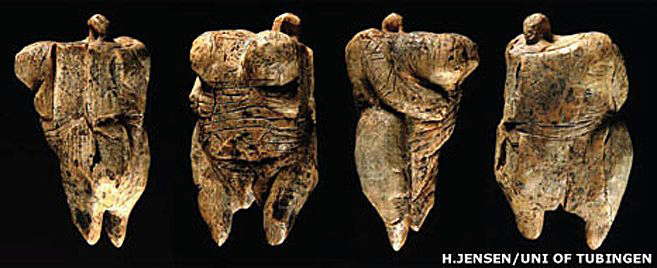
Four views of the venus.
Photo: H. Jensen/University of Tubingen
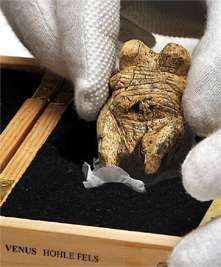
The Venus of Hohle Fels in its protective casket.
Photo: http://www.swp.de/nachrichten/regional/Regional;art1802,145971,D
Parts of another Venus of Hohle Fels found
22.07.2015
Archaeologists, Prof. Nicholas Conard and his team member Maria Malina, present the discovery of two fragments of a new female figurine in today‘s edition of the journal: Archäologische Ausgrabungen Baden-Württemberg. The figurine shows similarities with the well-known Venus from Hohle Fels that Prof. Conard published in 2009.
The two pieces of carved mammoth ivory fit together to form a find with dimensions of 23 x 22 x 13 mm. The find does not appear to be part of a depiction of an animal or lionman, both frequent motifs from the caves of the Swabian Jura of southwestern Germany. Instead, the find shows strong affinities with the only other female figurine known from the region. The find will be exhibited as part of a small research exhibit at the Museum of Prehistory in Blaubeuren.

Two views of the fragments of a female figurine from Hohle Fels in southwestern Germany dating to the Aurignacian period roughly 40 000 years ago.
( note that the fragments when fitted together are very similar in style, material and execution to a breast of the Hohle Fels venus - Don )
Photo: J. Lipták. © University of Tübingen
Source and text: https://www.uni-tuebingen.de/en/news/press-releases/
The female depictions from Hohle Fels date to 40 000 years ago are the oldest depictions of humans thus far recovered. While the new find is modest compared to the “Venus of Hohle Fels”, its form and the engravings on the surface show strong similarities with the more complete Venus. The new fragment, which represents a breast and part of the stomach, comes from a sculpture that appears to be slightly larger than the ca. 6 cm high discovery from 2008. Both female figurines come from the Aurignacian period during which modern humans rapidly spread across Europe, displacing the indigenous Neanderthals.
Prof. Conard remarks:” The new discovery indicates that the female depictions are not as rare in the Aurignacian as previously thought, and that concerns about human sexuality, reproduction and fertility in general have a very long and rich history dating to the Ice Age.”
Prof. Conard’s team has excavated at Hohle Fels over each of the last 19 years, and it is this long-term commitment that has over and over again paid off, to make Hohle Fels one of the best known Palaeolithic sites worldwide.
Text above: https://www.uni-tuebingen.de/en/news/press-releases/newsfullview-pressemitteilungen/article/es-muss-eigentlich-eine-frau-sein.html
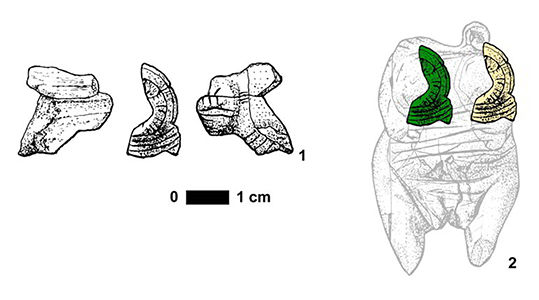
1.The carved and engraved mammoth ivory fragments form Hohle Fels Cave. 2. Reconstruction of how the new find fits in relation to the female figurine found in 2008.
Photo: M. Malina. © Universität Tübingen.
Source: https://www.uni-tuebingen.de/en/news/press-releases/
References
- Conard N., 2009: A female figurine from the basal Aurignacian deposits of Hohle Fels Cave in southwestern Germany. Nature, 2009; 459 (7244): 248 DOI: 10.1038/nature07995
- Cook, J., 2013: Ice Age art: arrival of the modern mind, The British Museum, 18 Feb 2013, ISBN-10: 0714123331, ISBN-13: 978-0714123332
Back to Don's Maps
 Back to Archaeological Sites
Back to Archaeological Sites
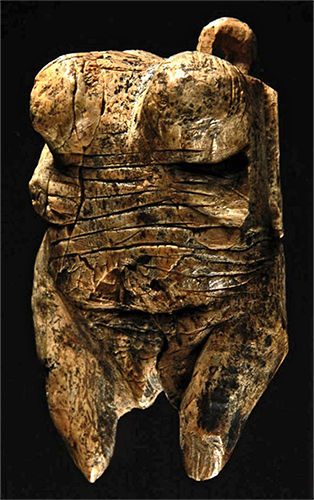
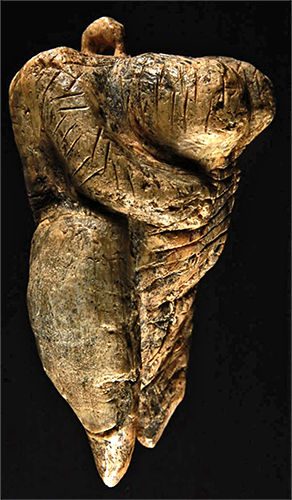
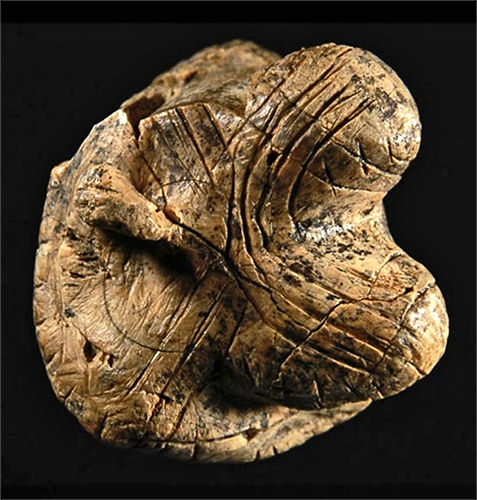
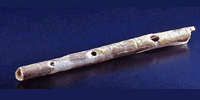 This page focuses on the site of Hohle Fels itself, rather than the venus, as well as the site of Geissenklösterle and other Middle Paleolithic sites in the Swabian Alb near the city of Ulm. Important areas of ice age art occurred near Ulm (Germany), in the Schwaebische Alb, in the valleys of the Ach and Blau river near Blaubeuren, where the famous lion/human figure was found in the Hohlenstein-Stadel cave. A number of world-wide famous caves, such as the Geissenklösterle, Brillenhöhle ('spectacle cave'), Grosse Grotte (great cave), Sirgenstein and Hohle Fels cave, can be reached from Blaubeuren on a labelled hiking path and are easily accessible from the important Museum für Ur-und Frühgeschichte which displays the earliest known flutes.
This page focuses on the site of Hohle Fels itself, rather than the venus, as well as the site of Geissenklösterle and other Middle Paleolithic sites in the Swabian Alb near the city of Ulm. Important areas of ice age art occurred near Ulm (Germany), in the Schwaebische Alb, in the valleys of the Ach and Blau river near Blaubeuren, where the famous lion/human figure was found in the Hohlenstein-Stadel cave. A number of world-wide famous caves, such as the Geissenklösterle, Brillenhöhle ('spectacle cave'), Grosse Grotte (great cave), Sirgenstein and Hohle Fels cave, can be reached from Blaubeuren on a labelled hiking path and are easily accessible from the important Museum für Ur-und Frühgeschichte which displays the earliest known flutes. 